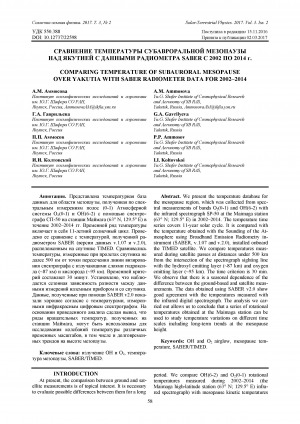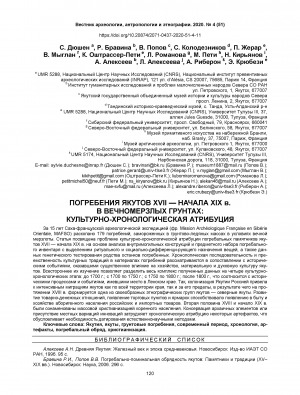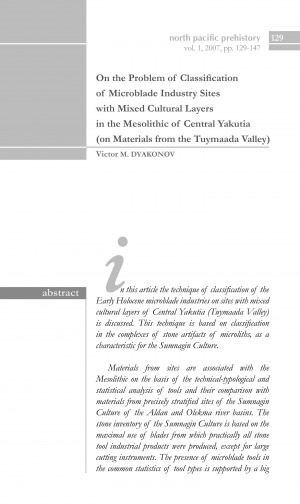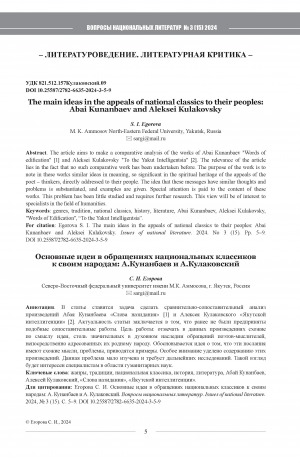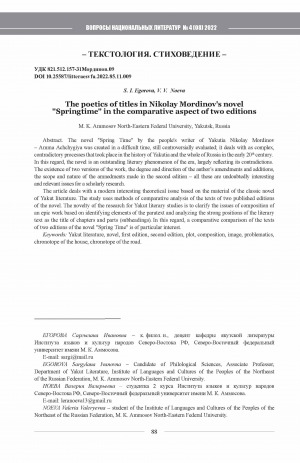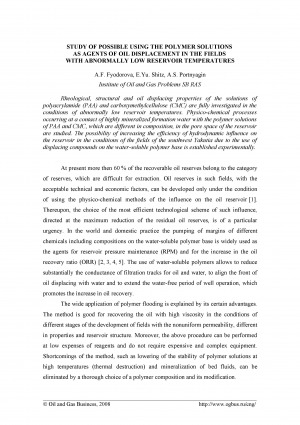Количество страниц: 6 с.
Comparing temperature of subauroral mesopause over Yakutia with SABER radiometer data for 2002–2014 = Сравнение температуры субавроральной мезопаузы над Якутией с данными радиометра SABER с 2002 по 2014 г. / A. M. Ammosova, G. A. Gavrilyeva, P. P. Ammosov, I. I. Koltovskoi // Солнечно-земная физика = Solar-Terrestrial Physics. – 2017. – Т. 3, N 2 : 13-я российско-китайская конференция по космической погоде. – С. 58-63. – DOI: 10.12737/22598.
DOI: 10.12737/22598
Количество страниц: 24 с.
На основе остатков ископаемых организмов, включая макрофоссилии растений, древесный уголь, пыльцу и беспозвоночных, сохранившихся в сингенетических отложениях Батагайской мерзлотной толщи Сибирско-Янского нагорья, мы реконструировали историю окружающей среды в течение морских изотопных стадий (MIS) 6-2. Две ископаемые коллекции, исключительно богатые растительными остатками, позволили детально описать палеорастительность во время двух климатических экстремумов позднего плейстоцена - наступления последнего ледникового максимума (LGM) и последнего межледниковья. Кроме того, всего 41 коллекция была использована для описания истории растительности с предпоследнего холодного этапа MIS 6. Соответственно, луговые степи, аналогичные современным сообществам фитосоциологического порядка Festucetalia lenensis, формировали основную растительность во время саальского и вейхзельского холодных этапов. Холодостойкие тундрово-степные сообщества (Caricirupestris-Kobresietea bellardii) в том виде, в котором они встречаются сегодня выше линии леса, в отличие от более северных районов, в основном отсутствовали. Во время последнего межледниковья основной растительностью на участке были открытые хвойные леса, похожие на современную лиственничную тайгу. Обилие древесного угля указывает на лесные пожары во время последнего межледниковья. Следовательно, луговые степи существовали на Янской возвышенности на протяжении всего исследуемого периода от МИС 6 до МИС 2, что свидетельствует об удивительной экологической стабильности. Таким образом, доля луговой степной растительности просто менялась в зависимости от преобладающих климатических условий. Их сохранение свидетельствует о низком количестве осадков и относительно теплом вегетационном периоде на протяжении всего позднего плейстоцена и после него. Изученная ископаемая летопись также доказывает, что современные степи на Янской возвышенности возникли не позднее голоцена, а являются реликтами ранее непрерывного степного пояса, простиравшегося в плейстоцене от Центральной Сибири до Северо-Восточной Якутии. Сохранение растений и беспозвоночных, характерных для растительности луговых степей во внутренней Якутии на протяжении позднего четвертичного периода, указывает на климатическую непрерывность и подтверждает пригодность этого региона в качестве арефугиума и для других организмов плейстоценовой мамонтовой степи, включая знаковых крупных травоядных
Woodlands and steppes: Pleistocene vegetation in Yakutia's most continental part recorded in the Batagay permafrost sequence / K. Ashastina, S. Kuzmina, N. Rudaya [etc.] // Quaternary International. - 2018. - Volume 196. - P. 38-61. URL: https://www.sciencedirect.com/science/article/abs/pii/S0277379118300672?via%3Dihub (дата обращения: 29.10.2024). - References: p. 58-61 (117 titles).
DOI: 10.1016/j.quascirev.2018.07.032
Количество страниц: 13 с.
- Религия. Теология,
- Общественные науки. Образование > Этнография. Обычаи. Жизнь народа. Нравы,
- Искусство. Фотография. Музыка. Игры. Спорт > Музыка,
- НАУКА ЯКУТИИ > РЕЛИГИЯ. ТЕОЛОГИЯ,
- НАУКА ЯКУТИИ > ОБЩЕСТВЕННЫЕ НАУКИ > Этнография. Обычаи. Жизнь народа. Нравы,
- НАУКА ЯКУТИИ > ИСКУССТВО. ФОТОГРАФИЯ. МУЗЫКА. ИГРЫ. СПОРТ > Музыка.
Dobzhanskaya, O. E. Samoyedic shamanic drums: some symbolic interpretations / Oksana Dobzanskaya // Shamanhood and Mythology Archaic Techniques of Ecstasy and Current Techniques of Research : Honour of Mihály Hoppál, celebrating his 75th Birthday / edited by Attila Mátéffy, György Szabados, Tamás Csernyei. - Budapest : Robinco, 2017. - 512 p. - P. 63-75.
Количество страниц: 13 с.
Dobzhanskaya, O. E. The opposition of the Nganasans ritual and non-ritual folklore music styles as a reflection ofthe ideas of the spatial organisation / Oksana Dobzanskaya ; Arctic State Institute of Culture and Arts // The Arctic in a space of knowledge :The collection of Saint Petersburg State University scientific events articles (2020–2021) / Saint Petersburg State University ; редактор: Nadezhda Kharlampieva. - Saint Petersburg : Saint Petersburg University Press, 2022. - P. 142-154
Источник: SHS Web of Conferences. - 2022, Т. 134.
Количество страниц: 7 с.
Целью данного исследования является изучение звукоиздающих подвесок на шаманском костюме эвенков, якутов и нганасан в единстве шаманского ритуального комплекса и ритуальных музыкальных традиций. Шаманские подвески интерпретируются как особый текст культуры, отражение геокультурных представлений народов Арктики. Статья основана на материалах полевых исследований, проведённых авторами на Таймыре в 1989–1990 годах, в Оленёкском эвенкийском национальном округе Якутии в 2014 году, а также на научных публикациях. Звуковой мир шаманского ритуала — это сложная звуковая картина, которая формируется при использовании вокальных, вербальных, вокально-речевых, сигнальных, инструментальных типов интонации. Движения шамана сопровождаются звуком сталкивающихся подвесок на костюме шамана и его составляющих (повязке, обуви, перчатках).
Звукоиздающие подвески были описаны этнографами и музыковедами, но не рассматривались в связи с геокультурными исследованиями. Металлические подвески на костюме шамана обозначают священные пространственные модели Вселенной (образы небесных тел — солнца, луны, звёзд), мифологические пространства Верхнего, Среднего и Нижнего миров, населённые духами-помощниками шамана — птицами, животными, антропоморфными существами, символизируют части человеческого тела и т. д. Перспективы изучения подвесок на костюме шамана как символического воплощения ландшафта заключаются в более полном описании и обобщении всех известных материалов, включая анализ костюмов шаманов из этнографических музейных коллекций.
Reflection of Arctic geocultures in the sounding attributes of the shaman costumes of Sakha, Evenks and Nganasans / Oksana Dobzanskaya, Vera Nikiforova, Varvara Dyakonova ; Arctic State Institute of Culture and Arts // SHS Web of Conferences. - 2022, Т. 134. - С. 1-7
Количество страниц: 12 с.
- Общественные науки. Образование > Этнография. Обычаи. Жизнь народа. Нравы,
- Краеведение. Археология. География. Биографии. История > Историческая наука. Историография > Археология,
- НАУКА ЯКУТИИ > ОБЩЕСТВЕННЫЕ НАУКИ > Этнография. Обычаи. Жизнь народа. Нравы,
- НАУКА ЯКУТИИ > КРАЕВЕДЕНИЕ. ГЕОГРАФИЯ. БИОГРАФИИ. ИСТОРИЯ > Историческая наука. Историография > Археология.
Frozen graves of Yakutia, a chronological sequence / S. Duchesne, R. Bravina, V. Popov [и др.] // Вестник археологии, антропологии и этнографии. – 2020. – N 4 (51). – С. 120-130. — DOI: 10.20874/2071-0437-2020-51-4-11.
DOI: 10.20874/2071-0437-2020-51-4-11
Количество страниц: 19 с.
Работа посвящена проблеме изучения мезолита в Центральной Якутии. Здесь было известно небольшое количество стоянок сумнагинской культуры, характеризующихся смешанными культурными комплексами, и датированных этим временем лишь по аналогиям инвентаря. В работе предложена методика определения раннеголоценовых комплексов в смешанных культурных слоях, основанная на выделении в общих комплексах каменного инвентаря микролитов, в большей степени характерных для сумнагинской культуры. Проведённый анализ позволил выделить сумнагинский культурный комплекс на 11 памятниках Туймаады. На ещё около 25 памятниках, где обнаружены микропластинчатые индустрии, при расширении работ, может подтвердиться предположение о наличии в культурных слоях мезолитического каменного инвентаря
Dyakonov, V. M. On the Problem of Classification of Microblade Industry Sites with Mixed Cultural Layers in the Mesolithic of Central Yakutia (on Materials from the Tuymaada Valley) / Victor M. Dyakonov // North Pacific Prehistory : archaeological studies journal. — 2007. — Vol. 1. — P. 129-147.
Количество страниц: 5 с.
- Языкознание. Филология. Художественная литература > Литература. Литературоведение > Теория литературы. Изучение литературы. Литературная техника > Художественная литература на отдельных языках > Якутская (саха) литература,
- НАУКА ЯКУТИИ > ЯЗЫКОЗНАНИЕ. ФИЛОЛОГИЯ. ЛИТЕРАТУРОВЕДЕНИЕ. ХУДОЖЕСТВЕННАЯ ЛИТЕРАТУРА > Литература. Литературоведение.
В статье ставится задача сделать сравнительно-сопоставительный анализ произведений Абая Кунанбаева "Слова назидания" [1] и Алексея Кулаковского "Якутской интеллигенции" [2]. Актуальность статьи заключается в том, что ранее не были предприняты подобные сопоставительные работы. Цель работы: отмечать в данных произведениях схожие по смыслу идеи, столь значительных в духовном наследии обращений поэтов-мыслителей, непосредственно адресованных их родному народу. Обосновывается идея о том, что эти послания имеют схожие мысли, проблемы, приводятся примеры. Особое внимание уделено содержанию этих произведений. Данная проблема мало изучена и требует дальнейших исследований. Такой взгляд будет интересен специалистам в области гуманитарных наук.
Egorova, S. I. The main ideas in the appeals of national classics to their peoples: Abai Kunanbaev andAleksei Kulakovsky / S. I. Egorova ; M. K. Ammosov North-Еastern Federal University // Вестник Северо-Восточного федерального университета им. М. К. Аммосова. Серия "Вопросы национальных литератур". - 2024, N 3 (15). - С. 5-9. - DOI: 10.25587/2782-6635-2024-3-5-9
DOI: 10.25587/2782-6635-2024-3-5-9
Количество страниц: 8 с.
Egorova, S. I. The poetics of titles in Nikolay Mordinov's novel "Springtime" in the comparative aspect of two editions / S. I. Egorova, V. V. Noeva ; Северо- Восточный федеральный университет им. М. К. Аммосова // Вестник Северо-Восточного федерального университета им. М. К. Аммосова. Серия "Вопросы национальных литератур". - 2022. - N 4 (08). - С. 88-95.
DOI: 10.25587/litteraesvfu.2022.85.11.009
Количество страниц: 12 с.
- Прикладные науки. Медицина. Ветеринария. Техника. Сельское хозяйство > Инженерное дело. Техника в целом > Горное дело. Горные предприятия (рудники, шахты, карьеры),
- НАУКА ЯКУТИИ > ПРИКЛАДНЫЕ НАУКИ. МЕДИЦИНА. ТЕХНИКА. СЕЛЬСКОЕ ХОЗЯЙСТВО > Инженерное дело. Техника в целом > Горное дело. Горные предприятия (рудники, шахты, карьеры).
Fyodorova, A. F. Study of possible using the polymer solutions as agents of oil displacement in the fields with abnormally low reservoir temperatures / A. F. Fyodorova, E. Yu. Shitz, A. S. Portnyagin // Нефтегазовое дело. - 2008, N 1. - С. 18.
